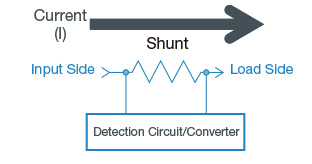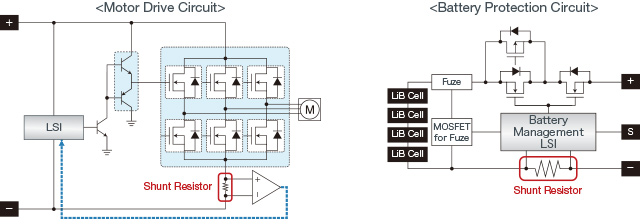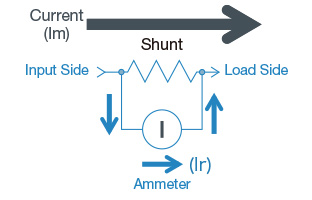What is a Shunt Resistor?
Shunt Resistors <Current Sence Shunt Resistors>
What is a shunt resistor (current sense shunt resistor)?
In the past, a resistor connected in parallel to an ammeter as a shunt to expand the current measurement range is called a shunt resistors, but in recent years resistors used to detect circuit current are collectively referred to as shunt resistors (current sense shunt resistor).
Shunt Resistors (Divider)
The word 'shunt', which has various meanings that include 'divert', 'avoid', and 'divide', conventionally refers to a resistor placed in parallel with an ammeter to shunt current.
To expand the measurement range of an ammeter a resistor is placed in parallel that shunts the current flow and the total current flowing to the circuit is measured.
For example, the total current (Im) flowing to the upper circuit can be expressed by the following equation.
Im=Ir+Ir (r/R)=Ir (1+r/R)
As a result, the ratio of total current flowing through the circuit with the current flowing through the ammeter
Im/Ir= (1+r/R)
will be.
That is, (1+r/R) times the current meter display (Ir: current flowing through the ammeter) is the total current flowing through the circuit.
Shunt Resistors(Series)
In a circuit in which resistors are connected in series, the potential difference (voltage drop) across the resistor is detected and current flowing in the circuit is measured using Ohm's Law.

For example, when current (I) flows a potential difference (V) is generated across the resistor.
This potential difference can be calculated using Ohm's Law.
V = I × R(Ohm's Law)
The current flowing through the circuit can be measured by detecting the voltage (V) using a detection circuit.
Since the current (I) and voltage (V) are proportional to each other, the actual variation in the current value (I) can be used as the change in detected voltage (V) and used for feedback control and threshold monitoring.

Shunt Resistors (Current Detection Resistors)Download datasheet
ROHM shunt resistors (Current Sense Shunt Resistors) were developed using metallic material processing technology cultivated over many years to ensure compatibility with a wide range of applications, from portable devices such as smartphones to automotive and industrial systems requiring a greater degree of reliability.
Shunt resistors (Current Sense Shunt Resistors) are widely used in the automotive and industrial markets to detect current in high power sets. In the automotive field, the shift towards computerization and electro-mechanical systems resulting from the need to provide greater safety and efficiency along with the emergence of electric vehicles has increased number of small motors and ECUs required, driving the demand for compact shunt resistors.
electronics_tips_menu





